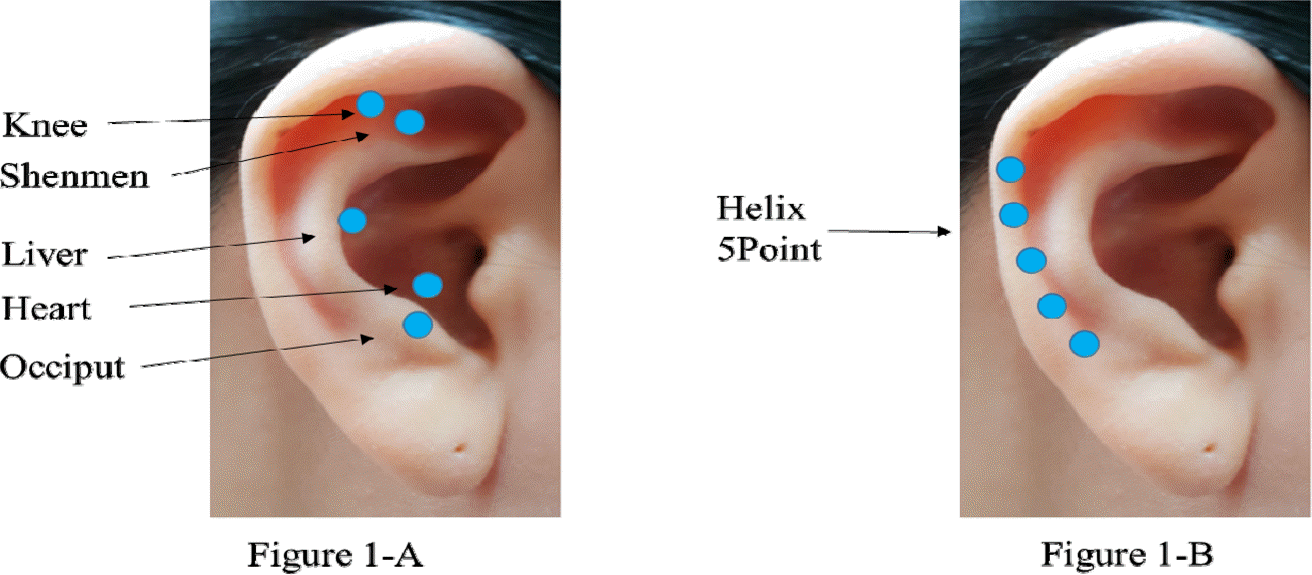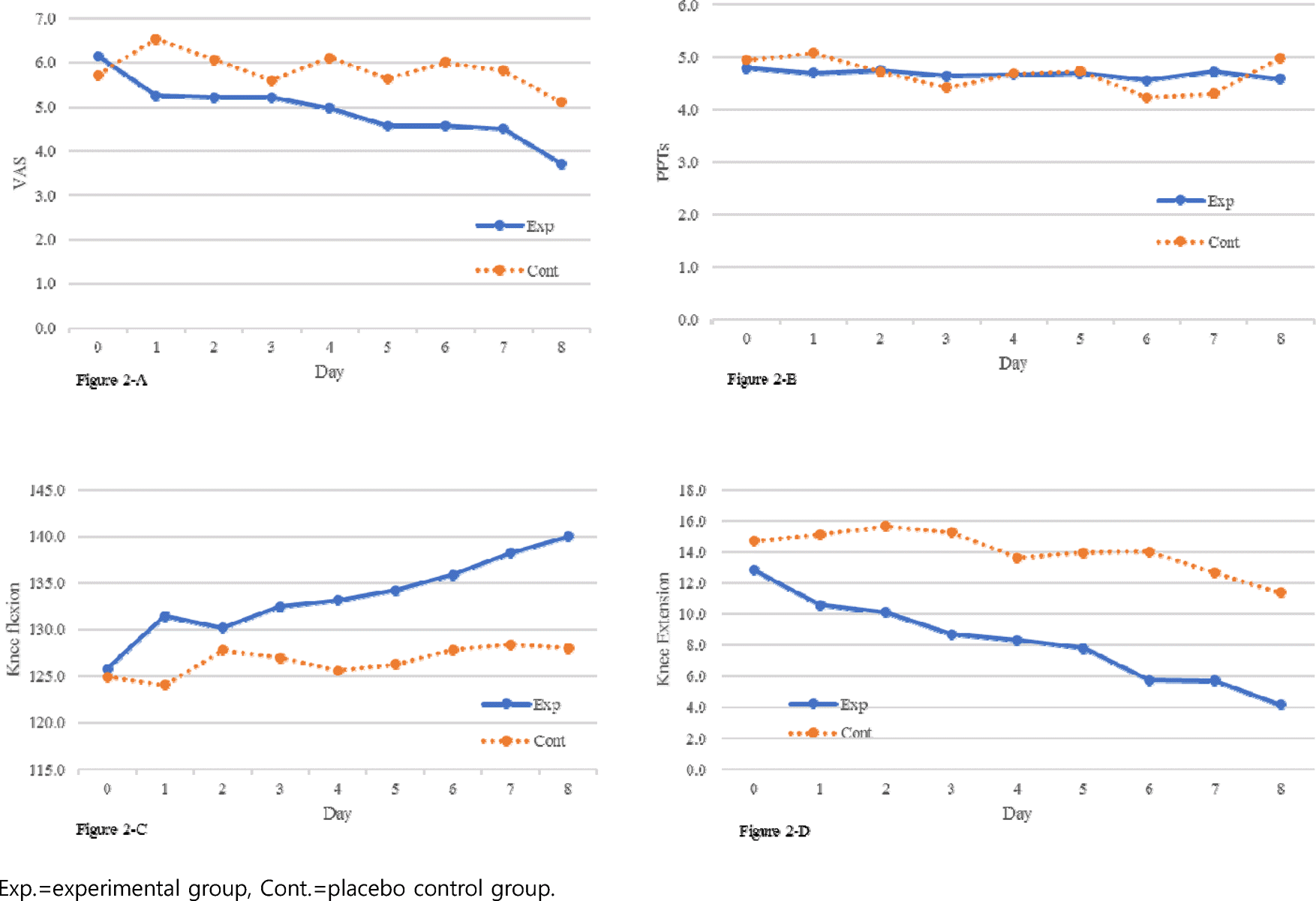Abstract
Purpose
The purpose of this paper is to determine effects of auricular acupressure on knee pain, range of motion, and sleep in the elderly with knee osteoarthritis.
Methods
This is an experimental study designed with randomization and single-blind in a placebo-control approach. The subjects included the elderly with knee osteoarthritis who were using an elderly welfare facility. In each of the groups, 28 subjects were assigned. For the experimental group, auricular acupressure was applied to five pressure points related to the pain caused by osteoarthritis and sleep. In the case of the placebo-control group, auricular acupressure was applied to other five points than the former. The intervention lasted eight weeks. In order to examine intervention effects of auricular acupressure, joint pain, Pressure Pain Thresholds (PPTs), and extension and flexion range of motion (ROM) were measured weekly. As for the pre-and post-examinations, pain, sleep quality, and the time-by-sleep stage of the patients with knee osteoarthritis were measured.
Results
The VAS scores in the experimental group with auricular acupressure significantly decreased through time (p<.001) and WOMAC also significantly decreased (p<.01) compared with the placebo-control group. However, there were no significant differences in PPTs. The flexion (p<.01) and extension (p<.001) ROMs measured for eight weeks improved over time. Meanwhile, sleep quality improved significantly after the intervention termination (p<.01), but there was no significant difference found in the time-by-sleep stage.
Go to : 
References
1. Korea Centers for Disease control & Prevention 2016. Korea national health & nutrition examination survey (KNHANES) [Internet]. Cjungju: KCDC;2018. [cited 2018 November 11]. Available from. https://knhanes.cdc.go.kr/knhanes/sub04/sub04_03.do?classType=7.
2. The Korean Orthopaedic Association. Knee Osteoarthritis [Internet]. Seoul: The Korean Orthopaedic Association;2011. [cited 2018 November 10]. Available from:. http://www.koa.or.kr/info/index_10_1.php.
3. Ondrésik M, Azevedo-Maia FR, da Silva Morais A, Gertrudes AC, Dias Bacelar AH, Correia C. . Management of knee osteoarthritis: Current and future directions. Biotechnology and Bioengineering. 2017; 114(4):717–739. https://doi.org/10.1002/bit.26182.
4. Juhl C, Christensen R, Roos EM, Zhang W, Lund H. Impact of exercise type and dose on pain and disability in knee osteoarthritis: A systematic review and meta-regression analysis of randomized controlled trials. Arthritis and Rheumatology. 2014; 66(3):622–636. https://doi.org/10.1002/art.38290.

5. Yi YM, Park YH. Experience of exercise maintenance in older adults with osteoarthritis: Focus group interview. Journal of Muscle Joint Health. 2018; 25(1):1–11. https://doi.org/10.5953/JMJH.2018.25.1.1.
6. Lee S, Kim SJ. Prevalence of knee osteoarthritis, risk factors, and quality of life: The fifth Korean national health and nutrition examination survey. International Journal of Rheumatic Diseases. 2017; 20(7):809–817. https://doi.org/10.1111/1756-185X.12795.

7. Kuralay C, Kiyak E. Sleep quality and factors affecting patients with knee osteoarthritis. International Journal of Caring Sciences. 2018; 11(2):1141–1146.
8. Pickering ME, Chapurlat R, Kocher L, Peter-Derex L. Sleep disturbances and osteoarthritis. Pain Practice. 2016; 16(2):237–244. https://doi.org/10.1111/papr.12271.

9. Kim JS, Park JS. A comparative study on health promotion behaviors by complementary alternative therapy utilization of elderly women with osteoarthritis. Journal of Digital Convert-gence. 2018; 16(2):451–459.
10. Hwang JH, Lee SO, Kim YK. Effects of thermotherapy combined with aromatherapy on pain, flexibility, sleep, and depression in elderly women with osteoarthritis. Journal of Muscle and Joint Health. 2011; 18(2):192–202. https://doi.org/10.5953/JMJH.2011.18.2.192.

11. Park KY, Park KS. Effects of a balance taping on pain and ROM of the knee joint in the elderly with lower limbs arthritis. Korean Journal of Adult Nursing. 2010; 22(3):312–321.
12. Han SS, Kim WO, Kim YJ, Back YH, Lee MH. Effects of moxibustion and theraband exercise on physical and psychological variables of the aged with degenerative osteoarthritis. Journal of East-West Nursing Research. 2008; 14(2):16–23.
13. Oleson T. Auriculotherapy manual: Chinese and western systems of ear acupuncture. 4th ed. Los Angeles: Elsevier Health Sciences;2013. p. 464 p.
14. Lee JO, Kim SJ, Kim JS, Park HH. Auricular acupressure. Seoul: Baflog;2010. p. 201 p.
15. You E, Kim D, Harris R, D'Alonzo K. Effects of auricular acupressure on pain management: A systematic review. Pain Management Nursing. 2019; 20(1):17–24. https://doi.org/10.1016/j.pmn.2018.07.010.
16. Suen LK, Yeh CH, Yeung SK. Using auriculotherapy for osteoarthritic knee among elders: A double-blinded randomised feasibility study. BMC Complementary and Alternative Medicine. 2016; 16(1):257–265. https://doi.org/10.1186/s12906-016-1242-6.

17. Chung BY, Park HS. Effects of non-pharmacological interventions for adults with insomnia in Korea: A meta-analysis. Journal of the Korean Academia-industrial cooperation Society. 2017; 18(1):95–106. https://doi.org/10.5762/KAIS.2017.18.1.95.

18. He BJ, Tong PJ, Li J, Jing HT, Yao XM. Auricular acupressure for analgesia in perioperative period of total knee arthroplasty. Pain Medicine. 2013; 14(10):1608–1613. https://doi.org/10.1111/pme.12197.

19. Hawker GA, Mian S, Kendzerska T, French M. Measures of adult pain: Visual Analog Scale for Pain (VAS Pain), Numeric Rating Scale for Pain (NRS Pain), McGill Pain Questionnaire (MPQ), Short-Form McGill Pain Questionnaire (SF-MPQ), Chronic Pain Grade Scale (CPGS), Short Form-36 Bodily Pain Scale (SF-36 BPS), and Measure of Intermittent and Constant Osteoarthritis Pain (ICOAP). Arthritis Care and Research. 2011; 63(S11):S240–S252. https://doi.org/10.1002/acr.20543.
20. Arendt-Nielsen L, Nie H, Laursen MB, Laursen BS, Madeleine P, Simonsen OH. . Sensitization in patients with painful knee osteoarthritis. Pain. 2010; 149(3):573–581. https://doi.org/10.1016/j.pain.2010.04.003.

21. Bellamy N, Buchanan WW, Goldsmith CH, Campbell J, Stitt LW. Validation study of WOMAC: A health status instrument for measuring clinically important patient relevant outcomes to antirheumatic drug therapy in patients with osteoarthritis of the hip or knee. The Journal of Rheumatology. 1988; 15(12):1833–1840.
22. Bae SC, Lee HS, Yun HR, Kim TH, Yoo DH, Kim SY. Cross-cultural adaptation and validation of Korean western ontario and mcmaster universities (WOMAC) and lequesne osteoarthritis indices for clinical research. Osteoarthritis Cartilage. 2011; 9:746–750. https://doi.org/10.1053/joca.2001.0471.

23. Norkin CC, White DJ. Measurement of Joint Motion: a guide to goniometry. 4th ed.Philadelphia: FA Davis Company;2009. p. 448 p.
24. Buysse DJ, Reynolds CF, Monk TH, Berman SR, Kupfer DJ. The pittsburgh sleep quality index: A new instrument for psychiatric practice and research. Psychiatry Research. 1989; 28(2):193–213. https://doi.org/10.1016/0165-1781%2889%2990047-4.

25. Schneider J, Schroth M, Ottenbacher J, Stork W. A novel wearable sensor device for continuous monitoring of cardiac activity during sleep. 2018 IEEE Sensors Applications Symposium (SAS); 2018 March 12-14. Seoul, South Korea: Institute of Electrical and Electronics Engineers: IEEE Xplore Digital Library;2018. p. 416 p. https://doi.org/10.1109/SAS.2018.8336725.

26. Chang LH, Hsu CH, Jong GP, Ho S, Tsay SL, Lin KC. Auricular acupressure for managing postoperative pain and knee motion in patients with total knee replacement: A randomized sham control study. Evidence-Based Complementary and Alternative Medicine. 2012; Article ID 528452. https://doi.org/10.1155/2012/528452.

27. Usichenko TI, Kuchling S, Witstruck T, Pavlovic D, Zach M, Hofer A. . Auricular acupuncture for pain relief after ambulatory knee surgery: A randomized trial. Canadian Medical Association Journal. 2007; 176(2):179–183. https://doi.org/10.1503/cmaj.060875.

28. Yeh CH, Suen LKP, Shen J, Chien LC, Liang Z, Glick RM. . Changes in sleep with auricular point acupressure for chronic low back pain. Behavioral Sleep Medicine. 2016; 14(3):279–294. https://doi.org/10.1080/15402002.2014.981820.

29. Lo C, Liao WC, Liaw JJ, Hang LW, Lin JG. The stimulation effect of auricular magnetic press pellets on older female adults with sleep disturbance undergoing polysomnographic evaluation. Evidence-Based Complementary and Alternative Medicine. 2013; Article ID 530438. https://doi.org/10.1155/2013/530438.

Go to : 
 | Figure 1.Auricular acupressure point for experimental group (1-A), and placebo control group (1-B). |
 | Figure 2.Changes in variables (2-A: Visual Analog Scale, 2-B: Pressure Pain Thresholds, 2-C: Knee Flexion, 2-D: Knee Extension) over time. |
Table 1.
Homogeneity Test of General Characteristics and Variables between the Two Groups (N=56)
| Characteristics | Categories |
Exp. (n=28) |
Cont. (n=28) |
x2 or t | p |
|---|---|---|---|---|---|
| n (%) or M±SD | n (%) or M±SD | ||||
| Age (year) | 79.21±5.40 | 78.35±5.55 | 347.00 | .459† | |
| Gender | Male | 0 (0.0) | 2 (7.1) | .491‡ | |
| Female | 28 (100.0) | 28 (92.9) | |||
| Height (cm) | 151.57±5.64 | 153.11±5.72 | 472.50 | .183† | |
| Body weight (kg) | 55.21±7.87 | 56.29±8.86 | -0.48 | .634 | |
| Time since diagnosis (year) | 5.39±5.76 | 5.58±5.33 | 405.00 | .829† | |
| Pain killer medication | Yes | 6 (21.4) | 9 (32.1) | 0.82 | .356 |
| No | 22 (78.6) | 19 (67.9) | |||
| Coffee intake | No | 6 (21.4) | 6 (21.4) | 5.76 | .124 |
| Once a day | 13 (46.4) | 8 (28.6) | |||
| Twice a day | 8 (28.6) | 7 (25.0) | |||
| ≥Three times a day | 1 (3.6) | 7 (25.0) | |||
| VAS | 6.14±2.01 | 5.71±2.35 | 0.73 | .467 | |
| Pressure pain thresholds (kg/cm2) | 4.80±1.50 | 4.95±1.20 | -0.42 | .676 | |
| WOMAC | 43.39±15.84 | 49.39±11.96 | -1.60 | .116 | |
| Knee Flexion | 125.78±12.00 | 124.93±11.35 | 0.27 | .787 | |
| Knee Extension | 12.81±7.23 | 14.69±5.98 | -1.06 | .295 | |
| PSQI | 10.00±2.39 | 10.14±2.29 | -0.23 | .820 | |
| Duration of sleep | Total | 333.11±80.37 | 332.86±85.96 | 0.01 | .991 |
| Awake | 62.96±24.59 | 57.29±15.65 | 1.03 | .308 | |
| REM sleep | 66.61±34.03 | 63.54±37.84 | 0.32 | .751 | |
| Light sleep | 221.82±56.11 | 222.36±69.47 | -0.03 | .975 | |
| Deep sleep | 43.93±21.62 | 46.89±28.68 | -0.44 | .664 |
Table 2.
Difference of Joint Pain and Range of motions between the Two Groups for 8 Weeks (N=56)
Table 3.
Difference of the WOMAC, Sleep-Quality, Duration of Sleep between Two Groups (N=56)




 PDF
PDF ePub
ePub Citation
Citation Print
Print


 XML Download
XML Download